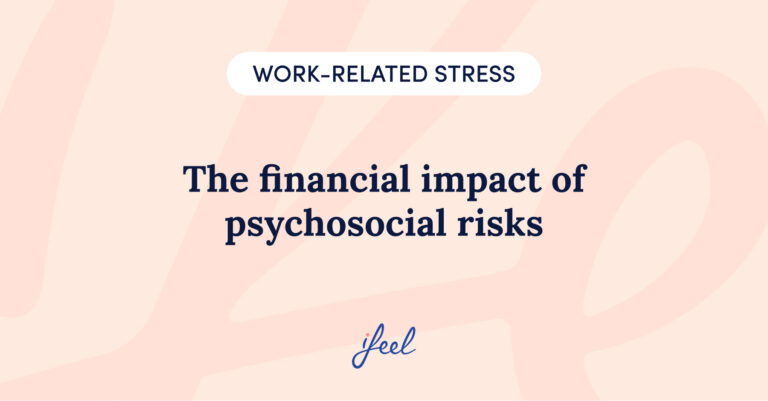Nowadays, mental health at work is one of the priorities of any organisation. However, little is said about the fact that this process must start from the top, i.e. creating a healthy work environment from the top down, so that the rest of the company follows suit and implements healthy working habits.
In this way, leaders and managers have a crucial role to play in fostering a culture that promotes the well-being and mental health of their employees and setting an example by taking care of their own mental well-being.
To do this, we encourage you to download our resource on caring for leaders’ mental health, which will provide your management team with essential tools for their well-being.
This article will explore how leaders can create a healthy work environment from the top down, providing practical, evidence-based strategies for building a positive and healthy work environment.
Importance of a healthy work environment
A healthy work environment improves employee satisfaction and engagement and directly influences productivity and the overall success of the organisation.
Conversely, the negative effects of a toxic work environment are significant and can manifest themselves in a variety of ways. Research has shown that employees who say they very often experience burnout symptoms at work are 63% more likely to take time off work, 23% more likely to visit the emergency room and are 2.6 times more likely to be actively looking for a different job.
These data reveal how burnout and stress affect not only the health of employees but also the stability and operational efficiency of the company. These factors also directly affect productivity and quality of work. When employees are continuously stressed and burned out, their ability to concentrate, make effective decisions, and collaborate with their colleagues decreases considerably.
Therefore, it is critical that leaders take a proactive approach to creating a healthy work environment from the top down. This includes promoting mental and physical well-being, implementing flexible work policies, and fostering a culture of support and recognition. Doing so not only improves employee satisfaction and engagement but also ensures optimal performance and productivity for the organisation.
Strategies for creating a healthy work environment from the top down
1. Promoting self-care and mental well-being
Leadership wellness is the first step in creating a healthy work environment; as leaders must lead by example by prioritising their own self-care. This includes:
- Ensuring that sufficient breaks and holidays are taken .
- Incorporating exercise into the daily routine.
- Balanced diet
- Practising relaxation techniques such as meditation and deep breathing.
- Ask for psychological support when needed.
From ifeel, we encourage you to download our resource on how to take care of leaders’ mental health. You will learn all about how to create a healthy work environment from the top, so that your management team learns essential tools to take care of their wellbeing.
2. Implement flexible working policies
Flexible working policies are essential to reduce stress and improve work-life balance. These policies can include:
- Remote working: Offer the option to work from home.
- Flexible working hours: Allowing employees to adjust their working hours to suit their personal needs.
- Wellness days or recharge days: Introduce additional days off to prevent burnout and exhaustion.
3. Encourage open communication and transparency
Open and transparent communication from top management to the rest of the workforce is crucial to create a healthy working environment from the top, building trust and support. Leaders should:
- Facilitate regular meetings: Hold regular meetings to discuss employee well-being and concerns.
- Create channels of communication: Establish channels where employees can express their ideas and concerns anonymously if they wish.
- Show empathy: Practice active listening and show understanding towards employees’ needs and problems.
David Peñaranda, Health & Safety Manager at ifeel partner Werfen, underlines the importance of a supportive environment:
‘What motivates me most about working at Werfen is the opportunity to freely express my ideas and those of my team in an environment where initiatives and differences are valued.’

4. Provide well-being solutions
Comprehensive wellness programmes that address physical and mental health are essential. Studies have found that they can reduce stress and increase job satisfaction.
These programmes can include:
- Wellness sessions: Mindfulness, yoga and meditation workshops.
- Psychological support: Access to counselling and therapy services.
- Physical activities: Company-sponsored fitness and exercise programmes.
“I put a lot of effort into self-awareness and prevention. Mental health doesn’t have a perfect formula for everyone, it requires us to know and listen to each other.”
-Beatriz Julian Almarcegui, Head of People at ifeel.
5. Set healthy boundaries
Leaders must set clear boundaries between work and personal life to avoid burnout and create a healthy work environment from the top down.
This includes:
- Digital disconnection: Encourage disconnection from work outside working hours.
- Reasonable working hours: Encourage a healthy balance and avoid excessive overtime.
- Respecting personal time: Do not expect employees to respond to emails or calls outside working hours.
6. Recognise and value work
Regular and meaningful recognition of employees’ work is essential to maintain motivation and commitment. In this regard, to create a healthy work environment from the top down, leaders should:
- Celebrate achievements: Publicly recognise employees’ achievements and contributions.
- Create incentive programmes: Provide incentives and rewards for good performance.
- Foster a culture of gratitude: Instill the practice of gratitude and daily recognition in the organisational culture.

Caring for mental well-being in organisations
At ifeel, we know that creating a healthy work environment from top management is not only a responsibility, but an investment in the long-term success of the organisation.
To assist in this process, our team of psychologists specialising in mental well-being has developed a mental well-being program for companies aimed at helping companies enhance employee engagement and boost productivity.
This collaboration allows HR managers to receive personalised, data-based advice on the most effective measures for detecting employee mental health issues and assessing the workplace climate. It’s the best way to understand their needs.
Moreover, ifeel’s corporate mental well-being solution offers employees a structured mental health care service tailored to their needs at any given time.
We hope you found this article on creating a healthy work environment from the top down interesting. If you want more information about our mental well-being solution for companies, simply request it, and we will contact your team soon.







